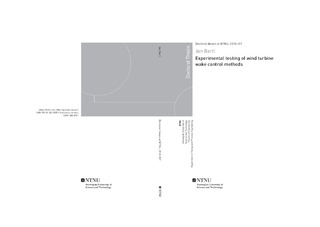| dc.contributor.advisor | Sætran, Lars Roar | |
| dc.contributor.advisor | Thamsen, Paul Uwe | |
| dc.contributor.author | Bartl, Jan | |
| dc.date.accessioned | 2018-04-27T07:04:08Z | |
| dc.date.available | 2018-04-27T07:04:08Z | |
| dc.date.issued | 2018 | |
| dc.identifier.isbn | 978-82-326-3005-9 | |
| dc.identifier.issn | 1503-8181 | |
| dc.identifier.uri | http://hdl.handle.net/11250/2496252 | |
| dc.description.abstract | In the light of the growing world-wide wind energy production, the optimization of wind farms has become an increasingly important field of research. Herein, the aerodynamic interactions between the single turbines through their wakes play a key role. The wake flow is characterized by lower velocities and increased levels of turbulence, causing power losses and fatigue loads on downstream turbines. Several different wind farm control concepts have been proposed, which are all based on the concept of reducing an upstream turbine’s power extraction for the benefit of additional power available for a downstream turbine. In this experimental wind tunnel study the most promising three concepts are investigated on a setup of two or three model-scale wind turbines. Additionally, two model-scale reference experiments for computational simulation tools for wake and airfoil flow are presented.
A comparison of intentional control of the upstream turbine’s tip speed ratio, blade pitch angle and yaw angle demonstrated the highest potential for overall power gains through yaw angle control. The wake flow behind a yawed turbine formed a curled shape at larger downstream distances and was observed to be slightly asymmetrical with respect to the upstream turbine yaw angle. However, the power surplus was observed to be penalized by increased yaw moments on both upstream and an aligned downstream turbine. For situations in which the turbines are laterally offset, an intentional yaw misalignment could steer the wake away from a downstream rotor, causing smaller loads and higher power. Moreover, it was demonstrated that a mitigation of yaw moments on the downstream rotor operated in a partial wake could be achieved by opposed yawing of the downstream rotor at a simultaneous increase of its power. For setups of tight inter-turbine spacing and full wake impingement tip speed ratio and pitch angle control might be applied for a reduction of upstream turbine thrust loads at an almost constant combined wind farm power. For higher turbine separation than x/D ≥ 3, however, the additional kinetic energy added to the wake flow by tip speed ratio or pitch angle control was observed to diffuse into the freestream and could not be recovered by a downstream turbine anymore.
A comparison of external wake flow predictions by different computational models with experimental reference data confirmed the supremacy of Large Eddy Simulations combined with an Actuator Line rotor model as well as hybrid Detached Eddy Simulations in this field. Both modeling approaches mastered the challenges of a sheared inflow (blind test 4) and the complex interaction of a partial wake inflow to a downstream turbine (blind test 5) distinctively. | nb_NO |
| dc.language.iso | eng | nb_NO |
| dc.publisher | NTNU | nb_NO |
| dc.relation.ispartofseries | Doctoral theses at NTNU;2018:107 | |
| dc.relation.haspart | Paper 1:
Bartl, Jan Michael Simon; Sætran, Lars Roar.
Experimental testing of axial induction based control strategies for wake control and wind farm optimization. Journal of Physics, Conference Series 2016 ;Volum 753.(3)
https://doi.org/10.1088/1742-6596/753/3/032035
Content from this work may be used under the terms of the Creative Commons Attribution 3.0 licence (CC BY 3.0) | |
| dc.relation.haspart | Paper 2:
Bartl, Jan Michael Simon; Ostovan, Yasar; Uzol, Oguz; Sætran, Lars Roar.
Experimental study on power curtailment of three in-line turbines. Energy Procedia 2017 ;Volum 137.(C) s. 307-314
https://doi.org/10.1016/j.egypro.2017.10.355
Under a Creative Commons license (CC BY-NC-ND 4.0) | |
| dc.relation.haspart | Paper 3:
Bartl, Jan Michael Simon; Mühle, Franz Volker; Schottler, Jannik; Sætran, Lars Roar; Peinke, Joachim; Adaramola, Muyiwa S.; Holling, Micheal.
Wind tunnel experiments on wind turbine wakes in yaw: effects of inflow turbulence and shear. Wind Energy Science 2018 ;Volum 3. s. 329-343
https://doi.org/10.5194/wes-3-329-2018
This work is distributed under
the Creative Commons Attribution (CC BY 4.0) | |
| dc.relation.haspart | Paper 4:
Bartl, Jan Michael Simon; Mühle, Franz Volker; Sætran, Lars Roar.
Wind tunnel study on power output and yaw moments for two yaw-controlled model wind turbines. Wind Energy Science 2018 ;Volum 3. s. 489-502
https://doi.org/10.5194/wes-3-489-2018
This work is distributed under
the Creative Commons Attribution (CC BY 4.0) | |
| dc.relation.haspart | Paper 5:
Bartl, Jan Michael Simon; Sætran, Lars Roar.
Blind test comparison of the performance and wake flow between two in-line wind turbines exposed to different turbulent inflow conditions. Wind Energy Science 2017 ;Volum 2. s. 55-76
https://doi.org/10.5194/wes-2-55-2017
This work is distributed under
the Creative Commons Attribution 3.0 License. (CC BY 3.0) | |
| dc.relation.haspart | Paper 6:
Jan Bartl, Kristian Sagmo, Tania Bracchi and Lars S tran. (2018)
Performance of the NREL S826 airfoil at low to moderate Reynolds numbers:
A reference experiment for CFD models.
© 2018. This manuscript version is made available under the CC-BY-NC-ND 4.0 license
Available online 9 October 2018 in
European Journal of Mechanics - B/Fluids
https://doi.org/10.1016/j.euromechflu.2018.10.002 | |
| dc.title | Experimental testing of wind turbine wake control methods | nb_NO |
| dc.type | Doctoral thesis | nb_NO |
| dc.subject.nsi | VDP::Teknologi: 500::Maskinfag: 570 | nb_NO |
| dc.description.localcode | Digital full text not available | nb_NO |
